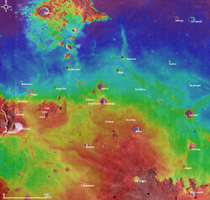Northern flank of Diophantus crater. LROC NAC M124797072L, 0.56 m/pixel, image width is about 678 meters. Illumination is from the bottom of the image, downslope direction is from top to bottom of the image.
This image from NASA's Lunar Reconnaissance Orbiter (LRO) reveals the upper slopes of Diophantus crater, located on the western edge of Mare Imbrium. The upper dark area of this image corresponds to the flat mare surface, outside of the crater. The most striking feature here is the dark material that flowed down the crater wall. The reflectance of surface materials is controlled by various factors such as sunlight direction, grain sizes and surface textures, and composition. In this picture, the dark materials are most likely a different composition (relatively bright materials also flowed down-slope next to the dark flows).
 |
| Click on image for larger version |
| Context map around Diophantus crater. Image center location is 326.34E, 27.63N. LROC WAC 100 m/pix mono-chrome global mosaic overlayed by WAC color DTM 500 m/px (DLR, Germany). Blue box at the image center corresponds to the footprint of today's featured NAC image |
NASA's Goddard Space Flight Center built and manages the mission for the Exploration Systems Mission Directorate at NASA Headquarters in Washington. The Lunar Reconnaissance Orbiter Camera was designed to acquire data for landing site certification and to conduct polar illumination studies and global mapping. Operated by Arizona State University, LROC consists of a pair of narrow-angle cameras (NAC) and a single wide-angle camera (WAC). The mission is expected to return over 70 terabytes of image data.

